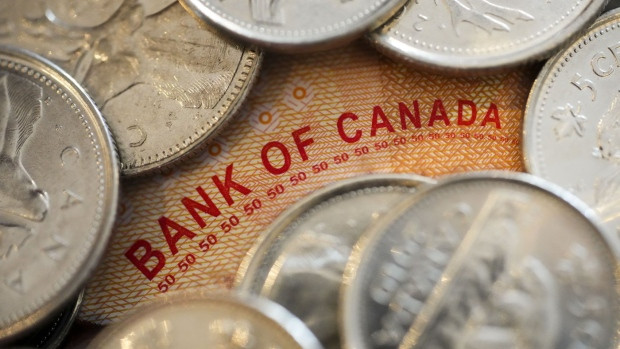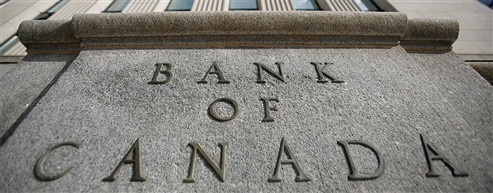The Bank of Canada is widely expected to deliver a third consecutive interest rate cut on Wednesday as inflationary forces continue to cool on both sides of the Canada-United States border. This move comes as the central bank has signalled a more dovish tone in recent months, with economists predicting cuts at every meeting for the remainder of the year and into 2025. The anticipated rate cuts come as inflation in Canada dropped to a 40-month low of 2.5% in July, edging closer to the Bank of Canada's target of 2%. Meanwhile, the labour market is showing signs of weakness, further prompting the central bank to consider more easing.
Markets are also calling for the U.S. Federal Reserve to start its own easing cycle later this month, a move that economists tell Global News will help set its Canadian counterpart up for more rate cuts to come. "They [Bank of Canada] are going to cut next week and retain the dovish bias that they've had for the last few months... the Canadian economy is in worse shape than the US and we've got a more interest rate sensitive economy," explained Taylor Schleich, rates strategist at National Bank of Canada. "As a result, they're going to continue to cut after this meeting, in October and December, and probably in the first few meetings of 2025 as well."
Derek Holt, vice-president and head of capital market economics at Scotiabank, tells Global News that he expects both the Bank of Canada and the U.S. Fed to deliver quarter-point rate cuts in September. The Fed is set to announce its next rate decision on Sept. 18, two weeks after the Bank of Canada. While the Canadian central bank is already 50 basis points into an easing cycle, its U.S. counterpart is playing catch-up.
Inflation has continued cooling for Canadians amid mild economic growth for much of 2024, allowing the Bank of Canada to start easing its benchmark policy rate from elevated levels in June. But concerns that inflation could reignite in the face of a still-hot economy south of the border were dampened by a particularly downbeat July jobs report in the U.S., cementing expectations that the Fed also needed to start cutting rates soon. Fed chair Jerome Powell confirmed in late August that “the time has come” for a long-awaited policy shift. The remarks must have been reassuring for Bank of Canada governor Tiff Macklem, who was at Powell’s side at the Fed’s monetary policy conference at Jackson Hole, Wyo.
The Impact of Rate Cuts on the Canadian Economy
Holt says that despite the Canadian central bank embarking on a rate-cut cycle ahead of the Fed, Macklem likely had a limited runway ahead of him. "I think the catch for Canada is that eventually we need the Federal Reserve to start easing policy itself," he says. "Otherwise, we would get to an earlier point at which the Bank of Canada’s easing probably would get stopped in its tracks." Macklem has maintained that he and his colleagues set monetary policy for Canada, not for the U.S., and that he is focused on the Canadian context when making interest rate moves. But the exchange rate between the Canadian and U.S. dollars is heavily influenced by the policy rates on the respective sides of the border. A bigger divergence between the rates could hurt the loonie compared with the American greenback as investors seek better returns in the U.S. dollar.
If the exchange rate takes too much of a hit, that could make American imports more expensive for Canadian businesses — a phenomenon that risks refuelling inflation. "I know the governor says that he’s not so fussed about the currency … but there’s a limit to that logic. If he were to continue to cut aggressively with the Fed on the sidelines, you’d get the Canadian dollar probably really softening," Holt says.
In fact, the CAD-USD exchange rate appreciated through much of the past month. Holt suggests that’s owed to both growing expectations that the Fed will join the Bank of Canada in cutting rates and to the “somewhat resilient” Canadian economy and oil prices.
The Path Forward for Interest Rates
Claire Fan, economist with RBC, says there’s still a lot more uncertainty about the rate path in the U.S. after September than there is for the Bank of Canada. Inflation has continued to cool towards the Bank of Canada’s two per cent target, last coming in at 2.5 per cent annually in July. Fan says the “softening economic background” also tells the central bank that inflationary risks appear largely “contained,” giving the bandwidth needed to continue lowering interest rates without worrying too much that inflation will reignite. She notes a shift among central bank communications away from putting heightened importance on every individual data point as confidence grows that conditions are in place to restore price stability.
Fan says the U.S. Fed will have to be more careful. There are plenty of outlying risks south of the border, not the least of which is the U.S. presidential election in November. "The path forward for Bank of Canada is a more certain one, we are anticipating the Bank of Canada to go slow, steady with easing rate cuts into the end of 2025," Fan says.
The Risks That Remain
Holt says that despite the runway for rate cuts, he’s not convinced the inflation risks are completely gone for the Bank of Canada. With a federal election in Canada currently scheduled for no later than October 2025 and Prime Minister Justin Trudeau’s Liberals trailing in the polls, Holt sees a risk that the incumbent government hikes spending in a bid to capture votes, stoking inflation as a side effect. He also points to renewed supply chain concerns tied to a looming port strike in the U.S., as well as the recent rail stoppage in Canada, as possible risks to the inflation outlook.
Despite a near-consensus among economists and market watchers that the path for interest rates in Canada is lower, both Holt and Fan warn not to expect oversized moves from the Bank of Canada, which is widely forecast to keep cutting rates by a quarter of a percentage point. Anything larger than that would send the wrong message to markets, Holt argues, that the Bank of Canada is looking to speed up the pace of easing. Market bets for more aggressive cuts would run counter to the central bank’s efforts to keep borrowing costs under control in the easing cycle, he says.
Holt says the message from the Bank of Canada has been that the rate-cut cycle won’t be as rapid as it was on the way up, when the central bank routinely delivered hikes of 50, 75, even 100 basis points at times to tamp down decades-high levels of inflation. The economy isn’t in an “emergency” scenario that warrants those kinds of sudden shifts, he argues. Fan agrees. While there have been signs of slowing in the economy and weakness in the labour market, Canada does not appear to be on the verge of a severe slowdown that would require a quick pivot to stimulating monetary policy. RBC expects the unemployment rate will rise a few more ticks to 6.7 per cent before levelling off and recovering somewhat starting in 2025 as interest rates ease and household and business spending picks back up. "The bottom really hasn’t fallen out of the economy to the extent that will require very steep rate cuts from the central bank just yet," Fan says. "Slow and steady is really how we are expecting the Bank of Canada to be approaching this upcoming easing cycle."
The Bank of Canada's Decision
A quarter-point cut this week would be the third in a row and bring the overnight rate down to 4.25 per cent. The consumer price index hit 2.5 per cent in July, its slowest pace in nearly three years. The Bank of Canada has forecast inflation will return to its two per cent target by the end of next year. "The last CPI print, when we looked purely at the number of components, nearly 50 per cent were growing at less than one per cent, so that’s pretty significant," said Jimmy Jean, chief economist at The Desjardins Group. "The story about inflation and why it’s still at two and half per cent, is largely about housing and it’s largely about rents in particular." Jean says no amount of monetary policy tightening can have an impact on housing, given it’s a supply and demand issue.
Following the central bank’s policy rate announcement in July, Bank of Canada Governor Tiff Macklem said the central bank’s “balance of risks is shifting,” meaning as inflation moves back to target, the bank is paying more attention to the downside risks to inflation and the economy. Economic growth in Canada came in stronger than expected in the second quarter, growing at an annualized rate of 2.1 per cent, above the Bank of Canada’s forecast of 1.5 per cent. However, momentum going into the third quarter looks to have slowed, according to preliminary estimates by Statistics Canada, with GDP growth flat in June and July.
The labour market has also become a concern: the unemployment rate jumped to 6.4 per cent in June and held there in July. Statistics Canada reported job vacancies were down 25.6 per cent in June compared to the year prior. Payroll employment also declined by 47,300 in June, compared to the month of May. If employment and the economy continues to deteriorate, Jean argues a steeper rate cut this fall could be a possibility. "Disappointing signals on the labour market front have kept coming and have been pretty persistent," said Jean. "A super-sized cut in October is not at all far-fetched in my opinion in Canada."
National Bank of Canada economists Taylor Schleich and Warren Lovely are also not ruling out the potential for a 50-basis-point cut this fall. "To be sure, our base case outlook doesn’t incorporate 50-basis-point moves this year and the Bank of Canada probably prefers to ease in more ‘normal’ increments, but the skew of labour market risks implies a larger cut in the fall is more likely than a pause," they wrote in a note to clients. As the bank’s easing cycle continues, forecasters expect the policy rate to fall to between 2.25 per cent and 3.25 per cent by the end of next year.
What's Next?
The Bank of Canada is set to announce its decision on interest rates on Wednesday, September 4. With inflation cooling and the economy showing signs of weakness, economists expect the central bank to lower its key rate by 25 basis points. This would mark the third consecutive rate cut and bring the Bank of Canada's key rate down to 4.25%.
As the central bank's easing cycle continues, forecasters expect the policy rate to fall to between 2.25 per cent and 3.25 per cent by the end of next year. The Bank of Canada's decision will be closely watched by investors and businesses, as it will provide insights into the central bank's outlook for the Canadian economy. "Clearly their rates should be lower than where they are now, and the bank’s moving slowly and surely in that direction," the Bank of Montreal’s Benjamin Reitzes told The Globe and Mail.


















